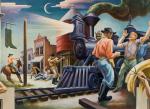COLUMBIA, Mo.—The walls of the House Lounge in Missouri’s state capitol building in Jefferson City come to life with the vibrant, colorful paintings of Thomas Hart Benton. The mural and its creation are profiled in the documentary “Tom Benton’s Missouri,” which has been remastered in a high-definition format. The HD edition will premiere around the state this fall for the film’s 20th anniversary.
The film will be shown at various public screenings on the university’s four campuses:
- Oct. 1, University of Missouri-Columbia
Reception: 6-6:45 p.m., The State Historical Society of Missouri
Screening: 7 p.m., Pickard Hall Auditorium, Museum of Art and Archaeology
- Oct. 3, University of Missouri-Kansas City, sponsored by New Letters
6:30 p.m., Student Union Theater
- Oct. 23, Missouri University of Science and Technology
7 p.m., Castleman Hall, Leach Theatre
- Oct. 31, University of Missouri-St. Louis
2 p.m., Gallery 210 Auditorium
The award-winning 1992 documentary, directed by Dr. James J. Bogan Jr., Curators’ Teaching Professor emeritus of art history and film at Missouri S&T, and Frank Fillo, former director of University of Missouri Extension’s Cooperative Media Group, was shown widely around the country on PBS stations and exhibited in schools around the state on 16 millimeter film and VHS tapes.
The new version is now available online at tombenton.missouri.edu in a free downloadable HD format and will include an educator’s guide that will provide lesson plans, background information on the mural, and lyrics and music from the film.
The restoration of the film included refinements to bring the colors into congruence with the original tempera paint of the mural. Bogan and Fillo used 16mm film instead of videotape to make the original movie because film does a better job of capturing the boldness of the mural’s colors, Bogan says.
“Film is truer to the colors Benton used, like the red-orange of Frankie’s dress in the panel that portrays the mythic ‘Frankie and Johnny’ shooting in a St. Louis barroom,” Bogan says.
“We wanted to try to recreate for the viewer the experience of standing in the House Lounge and looking in wonder at this mural,” Bogan continues. “We hope that seeing the film in high definition will be like looking through the eyes of a sensitive and knowledgeable spectator.”
The restored film also includes an enhanced soundtrack, which features narration by Benton himself and by historian Bob Priddy. Historical ballads written and sung by Bob Dyer provide a musical commentary to Benton’s vivid portrayal of Missouri history, which depicts farmers, slaves, politicians, housewives, factory workers, children and businessmen.
“The mural is intended to portray a variety of people involved in their natural, daily activities that did not require being polite,” Bogan says.
“Collaboration between campuses, professors and students, as well as the teachers of Missouri, has been the name of the game in refitting ‘Tom Benton’s Missouri’ for another generation of students – and for all Missourians,” says Bogan. “Missouri S&T, the University of Missouri-Columbia, and the UM System president’s office have combined talent and resources so that this vivid and evocative film can be seen by everyone. The digital technology employed will make it downloadable for free to anyone who cares to see it.”
“The Educator’s Guide to Tom Benton’s Missouri” was a collaborative effort of Luce Myers, lecturer in art at Missouri S&T, Kathleen Unrath, associate professor of art education at MU, and Abbey Trescott, a teacher at Rock Bridge High School in Columbia. It contains lessons in art, music, history and communication arts customized to suit students from fourth grade through college.
“This comprehensive study guide is full of interdisciplinary and cooperative learning lessons focusing on three enduring ideas found in the Benton murals – power, story and regional social identity,” says Myers. “It includes Missouri National History Standards for fourth grade and is a good companion for teachers who want to make that history come alive.”
Michael Hicks, film and video producer with the MU Extension Cooperative Media Group, oversaw the technical challenges of turning 16mm film in digital HD format. “Advances in technology has given us a cost-effective way to distribute this to the classroom and, we hope, excite a new generation of Missourians about the art and history of our state,” Hicks says.
Fillo, co-director of the original film, coordinated the section on music, which now offers some of the best recordings available of Bob Dyer’s songs about Missouri history. Gerald “Jack” Brown, a senior in civil engineering at Missouri S&T, and Jessica Hicks, an art education student at MU, served as research assistants on the project.
“Benton was once asked, ‘Why do you paint murals?’” Bogan says. “His answer? ‘Because I can put more stuff in them.’”
Read more http://extension.missouri.edu/news/DisplayStory.aspx?N=1535






